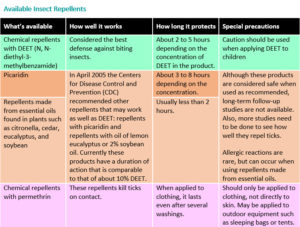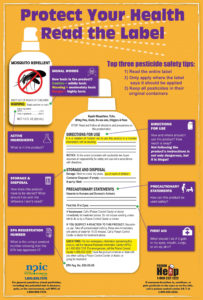Choosing Insect Repellent
Nothing looks prettier than legs full of mosquito bites by the end of the summer, but choosing the right insect repellent is more important than looks. Protection against mosquitoes and ticks can provide protection against more serious illnesses like Lyme Disease and Zika Virus. For me, choosing an insect repellent can be even more confusing than choosing a sunscreen. Because insect repellents have a reputation for higher toxicity than sunscreens, I personally have more hesitation when choosing one. Working on this article has helped me develop a better plan for confidently picking the insect repellent to best suit our needs.
Here are a few tips and LOTS of resources to help! Questions to consider are:
1 – What you are trying to avoid? – Mosquitos, ticks or both
2- How long do you need the protection to last?
3- Are you applying on a child or adult?
The two most common ingredients used in most insect repellents are DEET and picaridin.
As a mom, I am always concerned about not harming my kids while trying to protect them. Here are the two most common warnings I have found. According to the American Academy of Pediatrics, DEET should not be used on children under two months and should not be used in concentrations greater than 30%. They also state, “Do not use products that combine DEET with sunscreen. The DEET may make the sun protection factor (SPF) less effective. These products can also overexpose your child to DEET because the sunscreen needs to be reapplied often.” The CDC states, “ Do not use products containing oil of lemon eucalyptus (OLE) or para-menthane-diol (PMD) on children under 3 years old.”
If you want to avoid spraying the skin, other options include wearing long sleeves and pants and permethrin impregnated fabrics.
Addressing the use on pregnant and lactating women, the CDC states that… “When used as directed, EPA-registered insect repellents are proven safe and effective, even for pregnant and breastfeeding women.” EPA-registered insect repellents include… DEET, Picaridin (known as KBR 3023 and icaridin outside the US), IR3535, Oil of lemon eucalyptus (OLE), or para-menthane-diol (PMD), and 2-undecanone.

Because needs can vary so much, I am not making any overall recommendations on specific products in this post. Having these tools as a resource should help us all confidently make an effective and safe choice for protection.
Here are quite a few resources I found helpful.
National Pesticide Information Center
Consumer Reports – Insect Repellent Buying Guide
If you find these blog posts helpful, please share them on facebook, twitter or your social media preference using the buttons above. Also, you can email them to a friend.
If you would like to receive these posts in your email inbox Subscribe to our Site by clicking on this link.
